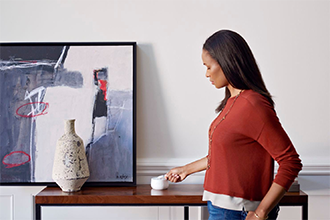In 2016, there were an estimated 1,053,000 home burglaries in the United States, according to FBI data. That means there’s a burglary about every 30 seconds.
These numbers alone help build the case for implementing a good security system in your home, but they aren’t the only reason for the urgency. In 2016, there were an estimated 1,053,000 home burglaries in the United States, according to FBI data. That means there’s a burglary about every 30 seconds.
These numbers alone help build the case for implementing a good security system in your home, but they aren’t the only reason for the urgency.
After all, burglars don’t discriminate. “Criminals are creatures of opportunity and wherever there’s an opportunity to strike, they will, be it in a big city or small suburb,” says Lee Walters, founder of FortifyMyHouse.com, a home-security education website. Translation: Even if you feel like you live in a “safe neighborhood,” you ought to have some type of security system.
Another reason to get one is because burglars tend to avoid houses with security systems. According to a University of North Carolina at Charlotte survey of convicted burglars, 83 percent said they would try to determine if an alarm were present before attempting a burglary, and 60 percent said they would seek an alternative target if there was an alarm.
Despite common perceptions, you don’t have to be wealthy to afford a home-security system. “Ten or 15 years ago, systems were at a price point where they were difficult to afford, but now there are a ton of affordable options for homeowners on any budget,” says Merlin Guilbeau, executive director and chief executive of the Electronic Security Association.
There are also financial advantages. Many insurance companies offer discounts on home insurance premiums when homeowners install an alarm system or security equipment.
Self-monitoring or professional system?
As more home-automation technology emerges, a growing number of homeowners are opting for self-monitored security equipment over systems that are monitored by professional security companies. Indeed, nearly half of Americans (49 percent) say they are open to installing their own home-security system, according to a 2016 LivSecure survey . Of course, there are pros and cons of taking this DIY approach.
Because there’s no monthly fee, many self-monitoring systems are cheaper than professional home-security systems. Proponents also say self-monitoring versions give homeowners a better sense of control over protecting their domain through access to live video feeds, mobile alerts, smartphone technology and other tools.
Still, a traditional, professionally monitored home-security system has advantages. Professional security systems will automatically alert authorities in an emergency situation, such as a break-in or a fire. (With self-monitoring systems, you have to make the call.) Also, with a security provider, “you have someone to contact should your system have any kind of service issues,” Walters says. A security company “can send out a technician to troubleshoot and fix a panel that’s gone bad, which you don’t have with a DIY approach.”
A security provider can also keep eyes on your house when you’re away on vacation, Guilbeau points out. And security providers will often offer to have an expert assess your home to help you determine the most effective setup for your house.
However, professional security providers tend to cost more. According to Consumer Reports, professional monitoring costs range from $100 to $300 annually, plus the cost of purchasing the equipment. In comparison, DIY system kits start at about $200. Also, professionally installed systems typically offer less flexibility. If you move out of your house, you may have to pay to have the system reinstalled at your new place.
3 options for DIY-ers
Want to take home security into your own hands? Let’s narrow the options.
At the very least, you’ll want to monitor your home’s exterior using a smart camera, such as the Nest Cam, which sends live video to your phone and detects motion and loud noises. You can get two outdoor Nest Cams (one for your home’s front entry and one for the backyard) for $298.
Looking for a more comprehensive security system? Consider iSmartAlarm, a top performer according to CNET, Consumer Reports and PCMag. Its Shield Package ($613.90), which includes eight contact sensors, seven motion sensors and three remote tags, is well-suited for a three- to four-bedroom house, the company says.
Another DIY option is the Abode Essentials Starter Kit ($229), which includes one door/window sensor, a battery-powered security camera and motion detector, and a key fob. The system integrates with Amazon Echo, Google Home and other home automations for voice-enabled arming and disarming.
3 options for professional monitoring systems
Want a professional security company watching your home? You have a lot of options, too.
Many self-monitoring systems offer professional monitoring services for an additional monthly or annual fee. With its Nest Secure alarm system, Nest offers professional monitoring through Brinks Home Security; there’s a three-year agreement that costs $19 a month and a month-to-month contract that’s $29 a month.
Frontpoint is a highly rated monitoring provider, according to security system review websitesSafeWise and A Secure Life. The price ranges from $34.99 to $49.99 a month, which is a tad high, but the system runs on cellular technology. Cellular technology is a good option because you don’t have to worry about cut wires, loss of Internet connection or power outages.
Depending on where you live, you could choose a local security company for a couple of reasons. “A local company will usually respond quicker to issues with the security system than will a national company, and local monitoring will have a better understanding of local crime trends than will a national monitor,” Walters says.
Don't forget basic security measures
A security system helps protect your home, but it can also create a false sense of security that might lead you to be less careful. Make sure you’re following these precautions:
•Lock all doors and windows when you’re out of the house. In about 40 percent of break-ins to unoccupied homes, offenders gained access through an unlocked door or window, the Bureau of Justice Statistics reports.
•Display security system yard and window signs. These signs can scare off burglars.
•Keep the lights on when you’re not there. Going on vacation? Try Ilumi lightbulbs ($19.99), which have timers inside that allow you to set the lights to go on and off at preset times.
•Don’t leave a spare key under the doormat (or another obvious place). This is home safety 101, but many people still make this mistake.
•Hold your mail at the post office when you’re out of town. If packages pile up at your door, burglars might see it as a sign that you’re not home.
•Avoid advertising your comings and goings on social media. Don’t share that you’re leaving for Bali on Facebook.




